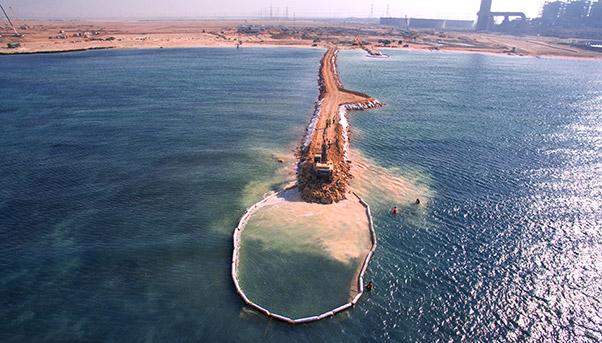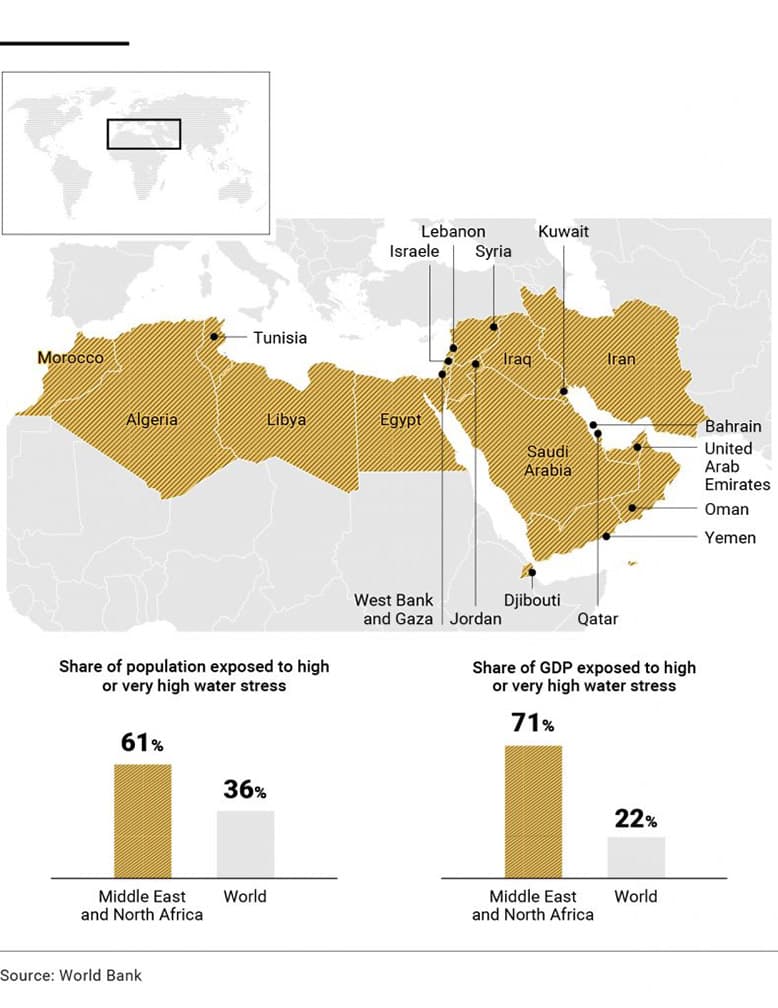
In the driest region of the world, water is simply a mirage, if not a challenge faced by millions of people each and every day.
In the Middle East and North Africa (MENA), where 17 countries find themselves below the water poverty line according to the United Nations, the goal is to find water where it is scarce, and – wherever possible – transform sea water into something drinkable and adequate for irrigation.
This process, called water desalination, is increasingly urgent in the MENA region, which is home to 6% of the world’s population but less than 1% of its drinking water, according to the World Bank.
Solving the problem of water shortage is becoming an urgent matter because it is no longer simply an historical condition in North Africa and the Middle Eastern where it has always been a fact of life. Rapid population growth, industrial development and climate change have added a new dimension to this age-old problem. The Food and Agriculture Organization of the United Nations sounded the alarm in 2014 when it identified 13 countries in the region as already suffering from water scarcity, defined as the level of available water dropping to below 500 cubic meters per person per year, including personal, agricultural and industrial use. This is too little on which to survive for very long. And it is scarce enough to make it necessary to create fresh water where it does not exist.
Desalination: Extracting fresh water from the sea
The most effective solution to water scarcity is desalination, or the complex process of removing salt from sea water to make it drinkable. According to calculations made by the World Bank, the MENA region is the world’s largest market for this type of process. Indeed, half of the world’s desalinated water is consumed in countries there.
Some 150 countries use desalinated water, and the International Desalination Association (IDA) estimates that more than 300 million people survive thanks to this technology.
IDA Secretary General Shannon McCarthy said in an interview with the CNN television network that the world’s desalination plants were mainly concentrated in the Persian Gulf countries, where in some cases desalinated water reached 90% of that used for domestic consumption.

Saudi Arabia is the world’s largest producer of desalinated water, and its plants are vital to easing a chronic water shortage that has reached acute levels. Of the country’s gross domestic product (GDP), 65% is in activities exposed to the risk of water shortage, while 64% of the population is vulnerable to it.
Salini Impregilo is making a contribution to solving Saudi Arabia’s water shortage problem through its Fisia Italimpianti unit, which is building the Shoaiba desalination plant on the country’s western coast where it will produce up to 250,000 cubic meters of water each day, supplying drinking water to more than one million inhabitants in Mecca, Jeddah and Taif.
Earlier this year, Saudi Minister for the Environment Abdulrahman Al-Fadhli announced plans to build nine desalination plants along the Red Sea coast, investing $530 million and further increasing the amount of fresh water produced with this technique.
Research, development, and constant innovation are necessary to compete in such a strategic sector, and to reduce the severe impact that water scarcity could have on people’s lives and the economies of entire nations.
Warding off the risk of an economic crisis
Water scarcity is tightly interwoven with economic development and, above all, with the growth prospects of countries affected by it. About 71% of the GDP in the MENA region is generated in areas where the level of water scarcity is very high, compared with 22% of GDP in the world economy at large. In absolute terms, that means that $2.5 trillion of GDP is produced in areas at risk, because available water is diminishing. At the moment, water shortages cost MENA economies $21 billion each year., according to the World Bank.
The outlook for the future – unless countries take significant measures and make a concerted effort to build more water treatment plants – does not look very rosy. By 2040, 60% of Middle Eastern and North African countries will be living in a continual water shortage emergency. By 2050, water scarcity could shave between 6% and 14% off the region’s GDP.
Reversing this trend is essential to safeguard economic development in this enormous region and to make sure the desert does not expand to a point of no return, which would extinguish hopes of human survival and well-being.

